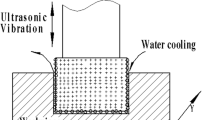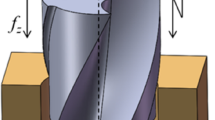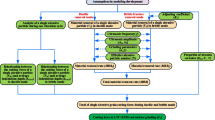Abstract
The longitudinal and torsional ultrasonic machining (LTUM) is an emerging ultrasonic vibration machining method, which is an innovation method based on rotary ultrasonic machining (RUM). Compared with one-dimensional longitudinal ultrasonic machining (LUM), LTUM has better performances and promising applicability. In this research, the machining mechanism and a drilling force model in longitudinal and torsional ultrasonic vibration drilling is proposed based on kinematic analysis. Besides, the kinematic model and track model in LTUM are established. In addition, the dynamic characteristics and cutting characteristics of the abrasive grains in LTUM are analyzed. Meanwhile, the material removal model for fracture material based on the indentation fracture theory in LTUM is considered. Based on the kinematic analysis and material removal model in the longitudinal and torsional ultrasonic vibration drilling, the cutting force model is developed and the relationship of cutting force with processing parameters and material parameters is investigated. Eventually, the verification experiment is carried out on carbon fiber-reinforced polymer (CFRP)-T700. The experimental result shows that the developed cutting force model predicts the cutting force accurately and the deviation is less than 10% in CFRP drilling. Additionally, the drilling experiment of LTUM, LUM, and conventional drilling (CD) are carried out respectively, and drilling force in the three processes are compared. The comparative analysis results show LTUM is superior to LUM and CD with lower drilling force and better performance.














Similar content being viewed by others
References
Komanduri R (1997) Machining of fiber-reinforced composites. Mach Sci Technol 1:113–152
Karpat Y, Bahtiyar O, Değer B (2012) Mechanistic force modeling for milling of unidirectional carbon fiber reinforced polymer laminates. Int J Mach Tools Manuf 56:79–93
Thoe TB, Aspinwall DK, Wise MLH (1998) Review on ultrasonic machining. Int J Mach Tools Manuf 38(4):239–255
Asami T, Miura H (2011) Vibrator development for hole machining by ultrasonic longitudinal and torsional vibration. Jpn J Appl Phys 50(7S):07HE31
Asami T, Miura H (2010) Characteristics of longitudinal and torsional vibration for hole machining by ultrasonic vibration. Proc 20th Int Congr Acoust 2010:1–8
Tsujino J (1995) Recent developments of ultrasonic welding. 1995 IEEE Int Ultrason Symp 2:1051–1060
Tsujino J, Ueoka T, Hasegawa K, Fujita Y, Shiraki T, Okada T, Tamura T (1996) New methods of ultrasonic welding of metal and plastic materials. Ultrason 34(2-5):177–185
Pei ZJ, Ferreira PM, Kapoor SG, Haselkorn MBAC (1995) Rotary ultrasonic machining for face milling of ceramics. Int J Mach Tools Manuf 35(7):1033–1046
Pei ZJ, Prabhakar D, Ferreira PM, Haselkorn M (1995) A mechanistic approach to the prediction of material removal rates in rotary ultrasonic machining. J Eng Ind 117(2):142–151
Pei ZJ, Ferreira PM (1999) An experimental investigation of rotary ultrasonic face milling. Int J Mach Tools Manuf 39(8):1327–1344
Pei ZJ, Ferreira PM (1998) Modeling of ductile-mode material removal in rotary ultrasonic machining. Int J Mach Tools Manuf 38(10-11):1399–1418
Liu D, Cong WL, Pei ZJ, Tang Y (2012) A cutting force model for rotary ultrasonic machining of brittle materials. Int J Mach Tools Manuf 52(1):77–84
Zhang QH, Wu CL, Sun JL, Jia ZX (2000) The mechanism of material removal in ultrasonic drilling of engineering ceramics. Proc Inst Mech Eng B J Eng Manuf 214(9):805–810
Hu P, Zhang JM, Pei ZJ, Treadwell C (2002) Modeling of material removal rate in rotary ultrasonic machining: designed experiments. J Mater Process Technol 129(1-3):339–344
Li ZC, Jiao Y, Deines TW, Pei ZJ, Treadwell C (2005) Rotary ultrasonic machining of ceramic matrix composites: feasibility study and designed experiments. Int J Mach Tools Manuf 45(12-13):1402–1411
Feng D, Zhao F, Xu Z, Guo D (2006) Mathematic model of material removal rate for ultrasonic milling. China Mech Eng 17(13):1399–1403
Bertsche E, Ehmann K, Malukhin K (2013) An analytical model of rotary ultrasonic milling. Int J Adv Manuf Technol 65(9-12):1705–1720
Yuan S, Zhang C, Amin M, Fan H, Liu M (2015) Development of a cutting force prediction model based on brittle fracture for carbon fiber reinforced polymers for rotary ultrasonic drilling. Int J Adv Manuf Technol 81(5-8):1223–1231
Amin M, Yuan S, Khan MZ, Wu Q, Zhu G (2017) Development of a generalized cutting force prediction model for carbon fiber reinforced polymers based on rotary ultrasonic face milling. Int J Adv Manuf Technol 93(5-8):2655–2666
Yuan S, Fan H, Amin M, Zhang C, Guo M (2016) A cutting force prediction dynamic model for side milling of ceramic matrix composites C/SiC based on rotary ultrasonic machining. Int J Adv Manuf Technol 86(1-4):37–48
Li Z, Yuan S, Song H, Batako AD (2018) A cutting force model based on kinematics analysis for C/SiC in rotary ultrasonic face machining. Int J Adv Manuf Technol 97(1–4):1223–1239 1-17
Li C, Zhang F, Meng B, Liu L, Rao X (2017) Material removal mechanism and grinding force modelling of ultrasonic vibration assisted grinding for SiC ceramics. Ceram Int 43(3):2981–2993
Li C, Zhang F, Meng B, Rao X, Zhou Y (2017) Research of material removal and deformation mechanism for single crystal GGG (Gd3Ga5O12) based on varied-depth nanoscratch testing. Mater Des 125:180–188
Lawn BR, Evans AG, Marshall DB (1980) Elastic/plastic indentation damage in ceramics: the median/radial crack system. J Am Ceram Soc 63(9‐10):574–581
Marshall DB, Lawn BR, Evans AG (1982) Elastic/plastic indentation damage in ceramics: the lateral crack system. J Am Ceram Soc 65(11):561–566
Collins JA (1993) Failure of materials in mechanical design: analysis, prediction, prevention. John Wiley, New York
Zhang C, Yuan S, Amin M, Fan H, Liu Q (2016) Development of a cutting force prediction model based on brittle fracture for C/SiC in rotary ultrasonic facing milling. Int J Adv Manuf Technol 85(1-4):573–583
Wikipedia contributors (2019) Vickers hardness test. In Wikipedia, The Free Encyclopedia. https://en.wikipedia.org/w/index.php?title=Vickers_hardness_test&oldid=887439831. Accessed 28 October 2018
Twomey B, Breen A, Byrne G, Hynes A, Dowling DP (2011) Rapid discharge sintering of nickel–diamond metal matrix composites. J Mater Process Technol 211(7):1210–1216
Wang Z, Zhang Z, Sun Y, Gao K, Liang Y, Li X, Ren L (2016) Wear behavior of bionic impregnated diamond bits. Tribol Int 94:217–222
Franca LFP, Mostofi M, Richard T (2015) Interface laws for impregnated diamond tools for a given state of wear. Int J Rock Mech Min Sci 73:184–193
Xu J, Sheikh AH, Xu C (2016) Interfacial failure modelling of diamond bits made of particulate composites. Compos Struct 155:145–159
Wu G (2017) High efficiency grinding boreholeand quality control of silicon carbide ceramics. Dissertation, Jiangsu University of Science and Technology
Gao C, Wu G, Wang S (2017) Drilling mechanism investigation on SiC ceramic using diamond bits. Open Mech Eng J 11(1):25–36
Funding
This research was financially supported by the Basic Scientific Research Program of China and National Natural Science Foundation of China (Grant No. U1737201). The authors are indebted to this financial support to accomplish this research work.
Author information
Authors and Affiliations
Corresponding author
Additional information
Publisher’s note
Springer Nature remains neutral with regard to jurisdictional claims in published maps and institutional affiliations.
Rights and permissions
About this article
Cite this article
Lu, Y., Yuan, S. & Chen, Y. A cutting force model based on kinematic analysis in longitudinal and torsional ultrasonic vibration drilling. Int J Adv Manuf Technol 104, 631–643 (2019). https://doi.org/10.1007/s00170-019-03884-y
Received:
Accepted:
Published:
Issue Date:
DOI: https://doi.org/10.1007/s00170-019-03884-y




